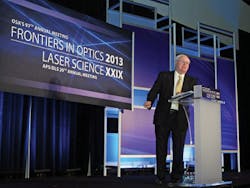As in past years, life sciences was a major focus of Frontiers in Optics (FiO) 2013 (October 6-10, Orlando, FL), the 97th annual meeting of The Optical Society (OSA). The event was co-located with the annual meeting of the American Physical Society (APS) Division of Laser Science (DLS), and dedicated one of its eight symposia to Optics in Biology and Medicine. A session called Translational Biophotonics—Focus on Pathology and Diagnostics highlighted the growth of photoacoustic microscopy (PAM), and explored the use of second-harmonic generation (SHG) and confocal fluorescence microscopy, along with near-infrared (NIR) and diffuse correlation spectroscopy. The session painted a rosy picture for the future of applications relying on optical techniques.
But other symposia also featured biomedicine, including the Vision and Color symposium that was dominated not by machine vision, as you might expect, but by ophthalmology; and the one on fiber optics that featured numerous bio applications. During a session on quantum information science, Steven Prawer (University of Melbourne, Australia) explained the potential use of diamonds with nitrogen vacancy (NV) defects in quantum biosensing and retinal implants. He described how the Bionic Vision Australia consortium has used the material to stimulate the retina with electrical pulses, and has created a bionic eye prototype that promises to help people with macular degeneration or retinitis pigmentosa to locate and interpret basic shapes.
In the exhibit hall, Bioptigen (Research Triangle Park, NC) announced the commercial release of its SD800 line of modular assemblies for optical coherence tomography (OCT) systems developers. According to the company, these are the only commercially available OCT modules able to acquire gigapixel volumetric images in real time at sub-3 μm axial resolution. The line, which includes four subsystems (a spectrometer, optical engine, light-delivery system, and workstation), aims to provide a practical level of integration to engineers, and to facilitate custom OCT application development. Bioptigen is best known for its Envisu spectral-domain ophthalmic imaging systems.
BRAIN keynote, plenary prize
A highlight was the keynote session on the White House Brain Research through Advancing Innovative Neurotechnologies (BRAIN) Initiative, a proposed $100 million project that aims to transform our understanding of the brain. This session was chaired by Cornell University's Chris Xu, who said that to achieve a goal of noninvasive recording and manipulation of dynamic brain activity at a cellular level both broadly and deeply in awake and behaving animals, researchers need tools to enable imaging at sub-micron resolution, with depth and area measured in millimeters and square millimeters, respectively.
The session featured a talk by Columbia University's Darcy Peterka, a researcher in the lab of Rafael Yuste—who helped conceive the BRAIN Initiative and whose focus is a project called the Brain Activity Map (BAM).
Presentations by other leading scientists demonstrated how biophotonics can facilitate neuroscience, and Prem Kumar of the U.S. Defense Advanced Research Projects Agency (DARPA) gave a funding agent's perspective. Participants recognized challenges of the initiative, some related to optics (light scattering) and some not (scaling up to study the human brain).
During the plenary session, biomedical optics pioneer Robert R. Alfano, Ph.D., Distinguished Professor of Science and Engineering at City College, City University of New York, was honored with the American Physical Society's Arthur Schawlow prize. The Schawlow prize, "the most prestigious and highest honor a laser physicist can [receive]," mainly honors Alfano's discovery of the white-light supercontinuum laser and several Cr4+/Cr3+ tunable lasers—research, he said, that was built upon knowledge gained and advice received as a young scientist from a number of mentors. He acknowledged the critical contributions of many smart, hard-working students. Alfano is a member of the board of advisors for the upcoming Strategies in Biophotonics.

